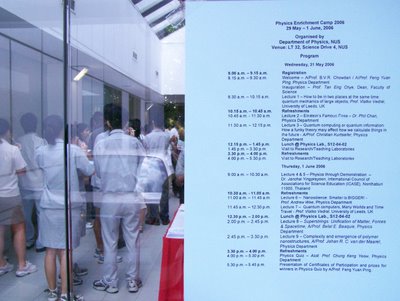
The Physics Enrichment Camp is organised by the Physics Department annually, catered to JC students as well as PRC students undergoing bridging course (admitting into Faculty of Science in the coming academic year). With two sessions lasting two days, spanning from 290506 (Mon) to 010606 (Thu), the camp was jammed pack with great stuff: a series of lectures by invited guests and NUS professors, a myriad of fun demo experiments and visits to research labs. And the lunch and refreshments was amazingly great too, though I must say yesterday's was a bit of a disappointment.
I was helping out with the experiment demonstrations, which took place on the first days (Monday and Wednesday). I also went for the morning lecture yesterday by an invited lecturer from Thailand, Dr Janchai Yingprayoon, who I am told is a must-see (which I wholly agree). Anyway, the experiments I was to explain (together with another super-smart guy who takes seven modules a semester) were the resonance bowl, resonance vibration, sound and signal generator and Doppler rocket.
Resonance Bowl
The resonance bowl is also known as the Chinese sprouting bowl, which is basically a copper-bronze basin with two handles. When I wet my hands and rub on the handles, there will be friction and that will cause the bowl to vibrate. This will in turn vibrate the water, resulting in standing waves on the surface due to the geometry of the bowl. So once the amplitude is sufficiently large, the water will fly off the surface.
Below is a video of a quick demonstration I did. I first tried getting the first harmonic (the intended resonating mode for the bowl), which has four antinodes (maxima), and later the second harmonic, which has ten antinodes (very hard to see in the video). Note the difference in resonanting frequency (sound) of both harmonics.
Resonance Vibration
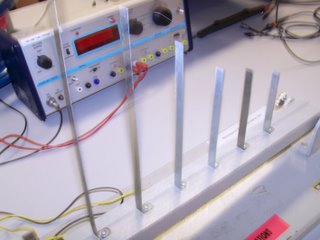
The setup for this is rather crude, as you can see from the picture. It is essentially six pieces of metal mounted on a bar (supported by a spring) with an oscillator (part of it is in the bottom left of the picture). The frequency of the oscillator can be varied. At certain frequencies which are integral multiples of the natural frequencies of the metal pieces, the metal pieces will start to resonate and shake rather violently. The second piece from the left in the picture is in fact undergoing resonance (I should've lowered the shutter speed to capture its motion).
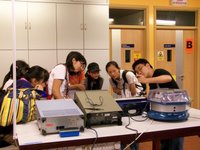
Sound and Signal Generator
The title was rather a mouthful, but this is simply a setup which emits sound at the frequency selected. With it, one can test the frequency he/she can hear. Also, it is rather fun to turn the frequency knob up and down, so that the sound will vary in a pretty funny way (it was commented by one student that the varying sounded like R2D2).
Doppler Rocket
The Doppler Rocket is actually a cushioned oval ball (like a smaller version of a rugby ball) with strings attached to both ends. There is a switch which turns on a sound that is emitted at a particular frequency (pitch). When the Doppler Rocket is swung in circles (in a manner like the blades of a helicopter), everyone (other than the demonstrator) will hear the pitch vary sinusoidally.
This is actually due to the Doppler effect, which is the phenomenon behind the higher pitch when a car approaches you and a lower pitch when it recedes away from you.
I've also played with other demo experiments in the same lab. One that is particularly of my favourite is the Gyro Ring. But it is hard to start it off, as you can see at the end of the video clip.
And the following are some of the other demonstrators in the same lab (the experiments were scattered over three labs):

Graduating student, teacher-in-training explaining the mechanisms behind a Crookes Radiometer.

VP of Physics Society (Physoc) explaining the difference between a full and a hollow cylinder rolling down a slope...
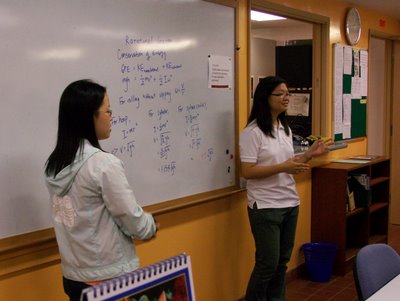
... as well as the maths behind it.

The rather simple but fun Cartesian Diver.
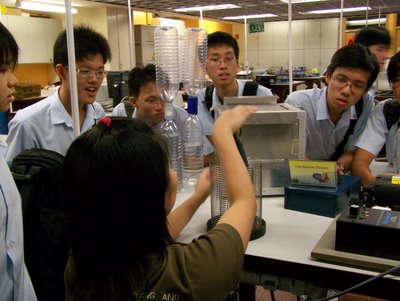
And this is an experiment that demonstrates the effects of a Faraday's Cage.

Mr President of Physoc sharing his knowledge on the plasma lamp.
And me playing with the plasma lamp:
And yesterday was the talk by Dr Yingprayoon.

He is not only a humourous speaker, he also knows how to engage with the audience as well as do very interesting experiments in the lecture itself.
And he also gave a nice little pack of "toys", of which the flipping top is my favourite (view the video).

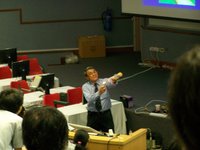
My participation in this camp reminded me of why I loved physics in the first place (not that I've lost interest, of course). One thing for sure, I'll be volunteering for the camp next year, as long as I can make it.

No comments:
Post a Comment